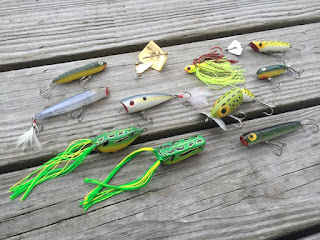The evolution of fishing gear and accessories along with the development of the bass fishing industry brought about the development of various lures specifically used for different fish species.
There are many types or class of lures and they all depend on what type of fish works for them. Many only work for specific types but some cover a wide range of species of fish.
There are many types or class of lures and they all depend on what type of fish works for them. Many only work for specific types but some cover a wide range of species of fish.
Below are some of the typical lures used for fishing.
Light Standard Casting Lures
For Standard casting lures, they are mostly able to attract a wide range of fish varieties from albacore, bluefish, bonita, oho and crappies. These lures are also excellent for certain species of bass fish and work best when retrieved from water at low to medium speed. They pass through water with undetectably synthetic material.
Their sizes are excellent for lightweight fish and a host of freshwater species. They range from 1/16 oz. to 3 oz.
The hand painted eye is enticing enough to allow schooling of fish. This feature allows for more chances of trapping one of the target fish in the water.
Heavy Standard Casting Lures
Heavy Standard Casting Lures are excellent for quite heavy fish specifically, walleye and bass. While the lightweight lures are used in most circumstances, it was shown that heavy counterparts provide more reliable fishing output.
Moreover, the heavy standard lures are able to catch fish than diamond and light standard casting lures.
Long Casting/Jigging Lures
Perhaps the most popular among the fishing lures are the long, tapered jigging lures. They are perhaps the most commonly used fishing lures among the fishermen in Florida, Mississippi and Louisiana.
Just recently, it was found out that the long casting lures work best for catching trout and pike. They were also found to effectively catch stripers and bluefish. They can catch tuna and walleye in a breeze!
Unlike heavy standard lures, this gear won’t produce good fish-catch output up to 180-200 ft under water but be sure to effectively match your lure color, bait and related accessories to maximize performance.
Deadly Diamond Lures
These lures are one of the smallest with sizes ranging from 1/8 to 1oz. They can seamlessly attract attention among fish and could form a school of fish in a minute!
The reason is it lies on its structural surface formation and cut. The top handle is cut like a diamond and causes the reflection of light striking on its surface. The diamond lures are best for catching bass fish varieties, crappie and stripers although they work on a small range of fish species.
Light Standard Casting Lures
For Standard casting lures, they are mostly able to attract a wide range of fish varieties from albacore, bluefish, bonita, oho and crappies. These lures are also excellent for certain species of bass fish and work best when retrieved from water at low to medium speed. They pass through water with undetectably synthetic material.
Their sizes are excellent for lightweight fish and a host of freshwater species. They range from 1/16 oz. to 3 oz.
The hand painted eye is enticing enough to allow schooling of fish. This feature allows for more chances of trapping one of the target fish in the water.
Heavy Standard Casting Lures
Heavy Standard Casting Lures are excellent for quite heavy fish specifically, walleye and bass. While the lightweight lures are used in most circumstances, it was shown that heavy counterparts provide more reliable fishing output.
Moreover, the heavy standard lures are able to catch fish than diamond and light standard casting lures.
Long Casting/Jigging Lures
Perhaps the most popular among the fishing lures are the long, tapered jigging lures. They are perhaps the most commonly used fishing lures among the fishermen in Florida, Mississippi and Louisiana.
Just recently, it was found out that the long casting lures work best for catching trout and pike. They were also found to effectively catch stripers and bluefish. They can catch tuna and walleye in a breeze!
Unlike heavy standard lures, this gear won’t produce good fish-catch output up to 180-200 ft under water but be sure to effectively match your lure color, bait and related accessories to maximize performance.
Deadly Diamond Lures
These lures are one of the smallest with sizes ranging from 1/8 to 1oz. They can seamlessly attract attention among fish and could form a school of fish in a minute!
The reason is it lies on its structural surface formation and cut. The top handle is cut like a diamond and causes the reflection of light striking on its surface. The diamond lures are best for catching bass fish varieties, crappie and stripers although they work on a small range of fish species.











